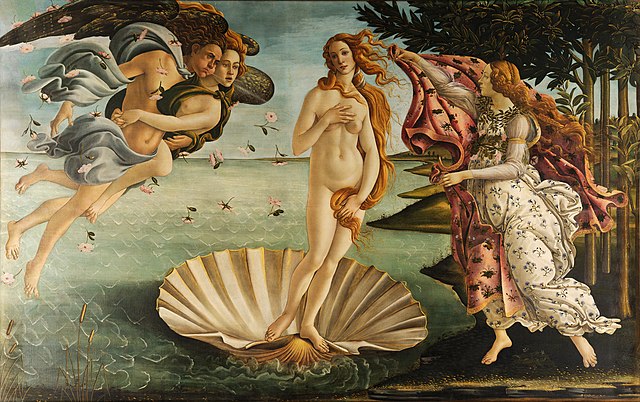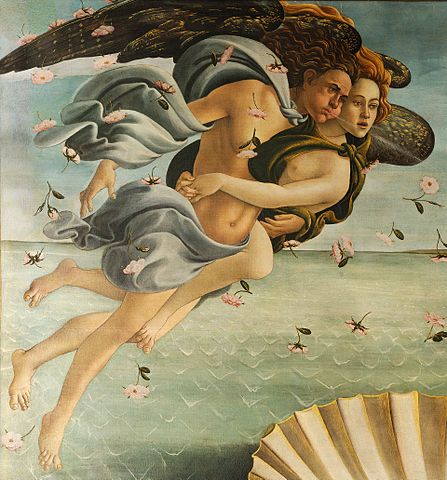Botticelli The Birth of Venus is one of the most famous paintings of all time. One that never ceases to capture our imaginations. Here we take a closer look at this masterpiece and some of the fascinating stories that surround it.
Botticelli painted the Birth of Venus between 1484-85. It was commissioned by a member of the Florentine Medici family, most likely Lorenzo di Pierfrancesco who was a distant cousin of Lorenzo the Magnificent. He also commissioned the artist to illustrate Dante’s Divine Comedy and “Allegory of Spring”. The birth of Venus was hung in his bedroom in the Villa in Castello, near Florence.
This painting is one of the masterpieces of Italian Renaissance and one of the highlights of the Uffizi Gallery in Florence.

Botticelli The Birth of Venus – What is the meaning?
The painting shows the triumphant Goddess of Love and Beauty. The Romans knew her as Venus, while for the Greeks she was Aphrodite. She stands tall and naked at the centre of the canvas, looking ethereal and luminous. She seems to draw all attention to herself; a symbol of beauty, who is both physical and spiritual. If you believe the neoplatonic philosophers, contemplating her beauty is a way to elevate the human spirit and get closer to the divine.
Representation of mythological subjects was trending in the Renaissance. Allegories taken from classical culture, olympian divinities and their mythologies were used to express humanistic values. And Botticelli’s city, Florence, was an important centre for humanist studies. Cosimo de’ Medici the Elder sponsored a Platonic Academy here, with philosopher Marsilio Ficino leading the way. With his Birth of Venus, Botticelli was following a trend, speaking the language of the cultured, and pleasing his patrons.

Why is she on a shell? The myth behind the painting
Venus, according to the Greek poet Hesiod who wrote the Theogony, was born out of sea foam. Ancient mythology is filled with blood and violence and this story is not an exception. The story goes that the God Uranus had a son named Cronus who overthrew his father, castrating him and throwing his genitals into the sea. This caused the water to be fertilised, and Venus was born.
After her birth she came ashore on a shell, pushed along by the breath of Zephyrus, the god of the west wind. In the painting we see Zephyrus embracing the nymph Chloris. The girl about to cover Venus with a flowery mantle is thought to be one of the Hours. They were the mythological handmaidens of Venus who also had power over the natural cycle of the seasons. The island she arrives at is Cyprus, or Citharea.
Find out about all the most celebrated paintings in the Uffizi Gallery.
The breath of Zephyrus was believed to have the power to fertilise and create new life. His embrace with the nymph symbolises the act of love.
=> 10 Curious facts you should know about Sandro Botticelli

The model Simonetta Vespucci
It’s very likely that the muse who inspired many of Botticelli’s women, included this Venus, was a well-known young blonde woman living in Florence at the time. Her name was Simonetta, and she was the wife of Marco Vespucci. This Marco was cousin of the famous Amerigo Vespucci whose name was given to the new continent of America.
Simonetta was a legendary beauty, and the Medici were besotted with her, especially Giuliano (Lorenzo the Magnificent’s brother). He openly flaunted his admiration for her, despite her being married. She died very young, at the age of 23, and is buried in Ognissanti Church in Florence. Botticelli asked to be buried at her feet, and the Vespucci family agreed. You can still see their tombs in this church today.
=> Check out 8 Famous Statues in Florence you absolutely have to see!

=> Art passionate? Find out about the fascinating “Adoration of the Magi” by Botticelli, where he depicted some members of the Medici family and his self portrait, and the celebrated mythological “riddle” Allegory of Spring by the same artist.
=> Uffizi Gallery in Florence: 7 Curious facts that you should know!
Naked beauty – A daring Renaissance subject
In classical art, naked male bodies were a common feature. Physical beauty was seen as a mirror of spiritual and moral qualities. Female representations were far less common, but among all the subjects, Venus was one of the most popular ones. The classical “Venus Pudicans” shows modesty by covering herself with her hands. Botticelli would certainly have had this example in mind when painting his Goddess.
During the Renaissance, naked men and women started to reappear after centuries of Medieval prudishness. Botticelli’s painting and Michelangelo’s gigantic David are the most striking examples.
Love art? Discover the most famous paintings to be found in Florence.
=> See the new Rooms open at the Uffizi Gallery!
=> See all of Botticelli’s paintings at the Uffizi Gallery, and discover how his style changed throughout his life.
Botticelli The Birth of Venus – Was it always so famous?
Definitely not. After centuries of oblivion, the painting was rediscovered only in the 19th century. Already in the last years of his life, Botticelli’s works were ignored. The artist had important rivals in the art world. He was overshadowed by revered characters such as Michelangelo and Leonardo.
Botticelli went through a moral and artistic crisis during the political turmoil that put the religious fanatic Savonarola in charge of Florentine government. It is believed that he also participated in the Bonfire of the Vanities in 1497, burning some of his own paintings that weren’t religious. Fortunately Botticelli The Birth of Venus was not among them.

